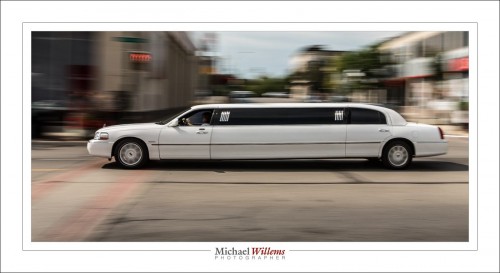No, not a non-urgent request for help from an aircraft. Not that kind of pan. I am talking about this kind of panning: moving along with the subject while using a slow shutter speed:
You do this as follows:
- Set your camera to the lowest ISO
- Set your shutter speed to, say, 1/20th second
- Fine whatever aperture matches this for a good exposure. You can use aperture mode, but I prefer manual mode. On a sunny day, you may need to cut light – if so, you can use a polarizing filter or a neutral density filter.
- Aim where the vehicle will be when you shoot (in front of you) and focus there. Now set focus to manual (i.e. you have now preset the focus for the right distance: that way, no time is wasted by the camera trying to focus).
- Wait for the car, and start tracking it before it gets to you. Moving smoothly now, shoot when the car is in front of you.
It’s really not difficult.
And you can see that the traffic lights in Canada work at 120Hz. How? I shoot at 1/20th second, and that gives me six little red men. 20×6 = 120, i.e. the red light is not continuous, but flashes on 120 times a second. (Can you tell I am an electrical engineer by training?) … Bonus question: approximately how fast is the car traveling?



Nice catch with the frequency of the red lights. This technique can be used at Honda Indy Race (next July). It will make for a nice blurred background.
To figure out how far the car went while the shutter was open, so you need to know the dimensions of something in the photo. Let’s say the blur of your sign is about the same width as the car’s rim. So the car went about 15 inches in 1/20th. That would be just over 27 KpH.
Of course, Murphy’s law says the result of a calculation will be close enough to seem reasonable, and far enough off to be significant. Being off an inch either way would result in a much different speed.
Your reasoning is exactly correct. Around 27-30kph depending on that tire size.